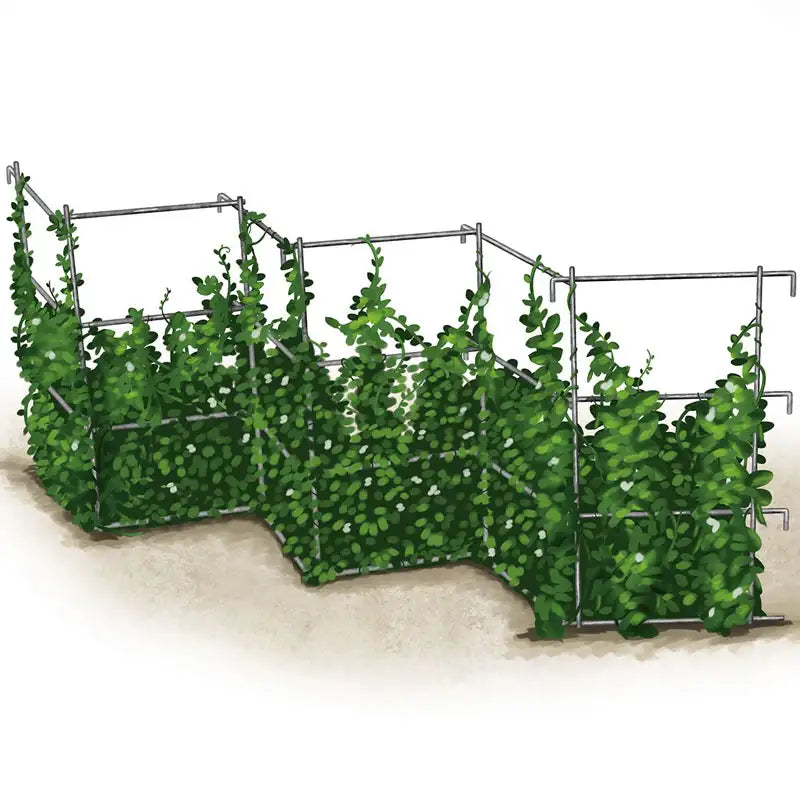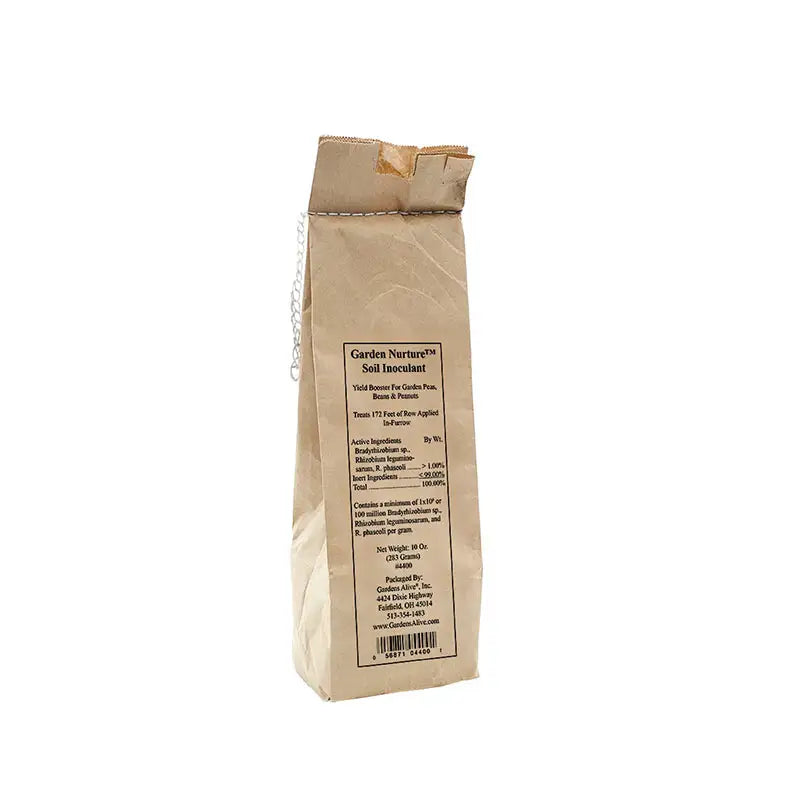Top Tips For LOTS of Spring Peas
I know--you might not like the idea of putting anything in the ground this early in the season. But there is a very good reason to get peas planted before April 1st.
They ARE called "SPRING Peas" for a reason: Peas are NOT a summer crop. As soon as it gets hot, the vines wither up and depart this mortal coil. If you wait till it seems a reasonable time to plant, your vines may shrivel and die just as the first peas are ready for picking. Get them in the ground before April Fool's Day and they'll have all of April and May to grow big and strong, and you'll be picking all of June.
Your basic pea pickin' choices are:
Sweet and crispy snow peas; pick 'em while they're still nice and flat and enjoy them 'pod and all' in salads and stir-fries (MY personal favorite type of pea!).
Southern favorite 'snap' or 'sugar' peas; let the pods get a little fatter on the vine before picking, then zip off and discard the strings and eat these sweet treats 'pod and all' as well.
And, of course, your basic 'English', 'garden' or 'shelling' peas; where you zip open the pod and just eat the tasty peas inside.
However, even SNOW pea seeds won't germinate outside if the weather turns (or stays) frigid. So, pre-sprout your seeds inside instead! You'll pick peas for six weeks this Spring instead of just two days! Surround your seeds with slightly wet paper towels, put 'em in a Ziploc bag, BUT DON'T SEAL IT, and leave them sit out in the open at room temperature. The seeds should sprout in 48 hours. If it's nice and warm plant 'em all. If it's cold, plant a few seeds (for luck), wait a few days for the weather to change and then plant the rest (for intelligence).
Dig a little trench next to a trellis, fence or tall, thin sticks jammed into the ground, so your vines will have something to climb. Add a tablespoon of wood ash per foot of row to 'sweeten' the soil, drop in your sprouted seeds (don't be afraid to crowd 'em to an inch apart--they love it!), cover with an inch of compost or seed starting mix, and water well.
Then be brave--if a cold wave hits, it may be a while before the sprouts shoot through the surface of the soil, but they will. Water weekly if it doesn't rain. For food, shovel some nice fresh finished compost around the plants when they get to be about six inches tall; water with compost tea every other week; or use a gentle organic packaged fertilizer. Pick promptly when the peas start coming--the more you pick, the more you get! (And the smaller they are the sweeter they'll be.)
And for the Advanced Class...
Get some 'pea and bean inoculant' at the garden center or through a catalog and roll your seeds around in the flour-like stuff before you bury 'em. Bacteria in the powder will form a symbiotic relationship with your plants, enabling them to suck plant-feeding nitrogen right out of the air. This also works with 'string' beans; in fact, these bacteria work their magic on all peas and beans (and other podding legumes). WAY cool.
Great science experiment: Start some peas 'with' and some 'without' the inoculant in little containers on a windowsill. Pull a few up after a month or so. The inoculated plants should have little round growths on their roots, showing that bacteria and plant have become one (better) organism!
If you miss the planting window in Spring, don't plant late; the-cool-weather-loving vines will just burn up in July. Instead, plan on putting in a Fall crop:
Pick the coolest spot in your garden (i.e. afternoon shade), put the seeds in the ground 90 days before your first expected frost date in the Fall, keep the young plants well-watered (and perhaps even cooled with some shade cloth or the shadow of taller plants, like corn or tomatoes) till summer's most torrid days are done, and think good thoughts. Remember--the plants like cool weather, so light frosts won't bother them a bit. Northerners can generally get a nice run of peas--lots if the frigid winter frosts hold off for a while and you're out there everyday picking. (Picking EVERY day is super-important with peas (and beans))!
A word or twenty about height:
Read catalog descriptions carefully. Most (maybe all) snow peas have a 'bush' style of growing that only requires around two to three feet of support; the word 'container' is also a good indication of petiteness.
Snap peas are variable, but most require at least five feet of support, which is good if you want the picking to be at a standing-up height.
English shelling peas are the tallest; nine feet high is not unusual. I have a ten-foot-high trellis that I bent in half, so they climb one side and then tumble down the other.
Above all else refer to the final height on the seed packet or catalog description. If it isn't listed, look up the variety on a different website. Oregon Sugar Pods and Green Arrow shelling peas will be the same height no matter where you get them.
They ARE called "SPRING Peas" for a reason: Peas are NOT a summer crop. As soon as it gets hot, the vines wither up and depart this mortal coil. If you wait till it seems a reasonable time to plant, your vines may shrivel and die just as the first peas are ready for picking. Get them in the ground before April Fool's Day and they'll have all of April and May to grow big and strong, and you'll be picking all of June.
Your basic pea pickin' choices are:
Sweet and crispy snow peas; pick 'em while they're still nice and flat and enjoy them 'pod and all' in salads and stir-fries (MY personal favorite type of pea!).
Southern favorite 'snap' or 'sugar' peas; let the pods get a little fatter on the vine before picking, then zip off and discard the strings and eat these sweet treats 'pod and all' as well.
And, of course, your basic 'English', 'garden' or 'shelling' peas; where you zip open the pod and just eat the tasty peas inside.
However, even SNOW pea seeds won't germinate outside if the weather turns (or stays) frigid. So, pre-sprout your seeds inside instead! You'll pick peas for six weeks this Spring instead of just two days! Surround your seeds with slightly wet paper towels, put 'em in a Ziploc bag, BUT DON'T SEAL IT, and leave them sit out in the open at room temperature. The seeds should sprout in 48 hours. If it's nice and warm plant 'em all. If it's cold, plant a few seeds (for luck), wait a few days for the weather to change and then plant the rest (for intelligence).
Dig a little trench next to a trellis, fence or tall, thin sticks jammed into the ground, so your vines will have something to climb. Add a tablespoon of wood ash per foot of row to 'sweeten' the soil, drop in your sprouted seeds (don't be afraid to crowd 'em to an inch apart--they love it!), cover with an inch of compost or seed starting mix, and water well.
Then be brave--if a cold wave hits, it may be a while before the sprouts shoot through the surface of the soil, but they will. Water weekly if it doesn't rain. For food, shovel some nice fresh finished compost around the plants when they get to be about six inches tall; water with compost tea every other week; or use a gentle organic packaged fertilizer. Pick promptly when the peas start coming--the more you pick, the more you get! (And the smaller they are the sweeter they'll be.)
And for the Advanced Class...
Get some 'pea and bean inoculant' at the garden center or through a catalog and roll your seeds around in the flour-like stuff before you bury 'em. Bacteria in the powder will form a symbiotic relationship with your plants, enabling them to suck plant-feeding nitrogen right out of the air. This also works with 'string' beans; in fact, these bacteria work their magic on all peas and beans (and other podding legumes). WAY cool.
Great science experiment: Start some peas 'with' and some 'without' the inoculant in little containers on a windowsill. Pull a few up after a month or so. The inoculated plants should have little round growths on their roots, showing that bacteria and plant have become one (better) organism!
If you miss the planting window in Spring, don't plant late; the-cool-weather-loving vines will just burn up in July. Instead, plan on putting in a Fall crop:
Pick the coolest spot in your garden (i.e. afternoon shade), put the seeds in the ground 90 days before your first expected frost date in the Fall, keep the young plants well-watered (and perhaps even cooled with some shade cloth or the shadow of taller plants, like corn or tomatoes) till summer's most torrid days are done, and think good thoughts. Remember--the plants like cool weather, so light frosts won't bother them a bit. Northerners can generally get a nice run of peas--lots if the frigid winter frosts hold off for a while and you're out there everyday picking. (Picking EVERY day is super-important with peas (and beans))!
A word or twenty about height:
Read catalog descriptions carefully. Most (maybe all) snow peas have a 'bush' style of growing that only requires around two to three feet of support; the word 'container' is also a good indication of petiteness.
Snap peas are variable, but most require at least five feet of support, which is good if you want the picking to be at a standing-up height.
English shelling peas are the tallest; nine feet high is not unusual. I have a ten-foot-high trellis that I bent in half, so they climb one side and then tumble down the other.
Above all else refer to the final height on the seed packet or catalog description. If it isn't listed, look up the variety on a different website. Oregon Sugar Pods and Green Arrow shelling peas will be the same height no matter where you get them.




